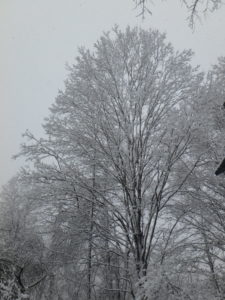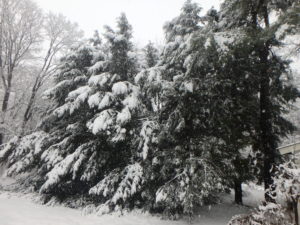Magnificent Trees for the Winter Landscape
This is not the time for planting trees in New England. But it is a good time for looking at them and deciding what to plant, come spring and summer. Since we have 5 months or so without flowers growing in our gardens, look at the silhouettes of trees, decide what pleases you, and read up on them.
Most gardeners plant some flowers, a few veggies and perhaps some nice decorative shrubs. Fine. But what about maples, oaks and beeches? Should we allow the squirrels to decide where these majestic trees grow on our property? No, we should plant them if we like them – and have space for them.
My property is relatively small, just a couple of acres, so I have been judicious in selecting trees to add to the landscape. My property came with a few big sugar maples and oaks, two American elms, one huge wild cherry and too many poplars for my liking. The elms died and had to be cut down, but the rest of the big trees continue to get even bigger, cooling the house in summer and providing food and homes for birds and small mammals.
One of my favorite big trees is a hybrid magnolia, the “Merrill”. I planted it about 20 years ago, and is near mature size now – at least 30 feet tall and wide. It blooms with big white fragrant blossoms every year in late April. It has glossy green leaves all summer, and fabulous fuzzy buds similar to pussy willows all winter. It was just 4 feet tall when I planted it.
I planted it in the middle of a lawn where it would get full sun. It is near my little stream and I worried that the high water table would lead to root rot, but it has thrived with plenty of water. Unfortunately it does spill some shade onto a vegetable plot in late afternoon. But I love it, and am glad I can see it from my windows.
I have planted several fruit trees, both apples and pears, and have several wild apples that blossom nicely but do not produce edible fruit. I think every gardener should have at least one apple tree. Books will tell you that you need 2 or more apples to get good pollination, but there are always wild apples, or apples at your neighbor’s house to provide good pollination if you have room for only one.
There are many disease-resistant apple varieties to choose from if you don’t want to spray chemicals. ‘Liberty’, ‘Freedom’, ‘MacFree’ and others are less likely to get apple scab, powdery mildew, cedar apple rust and fire blight. That said, be sure to pick an apple you have tasted and like. You can prune any apple tree to look good.
Sugar maples mature more quickly than you might think. A tree with a 2-inch diameter stem can become a handsome shade tree in 20 years – they can average a foot a year or so. They don’t tolerate road salt or compacted soils, but otherwise are easy to grow. They can benefit from occasional doses of limestone for their roots, as acid rain washes calcium out of the soil, and they need it to stay healthy. Maples are, to me, the quintessential New England tree with the classic red, orange and yellows of our fall.
If you want a big oak in your yard, consider playing squirrel. A friend of mine did this, gathering acorns locally and planting a dozen or more. Some germinated, others did not, and some he had to thin out. Remember that a mature oak can reach 60 feet tall or more. Width can vary from 25 to 60 feet wide, depending on the species. One of the fastest growing oaks in the pin oak, which can reach 12 to 15 feet in 5 to 7 years.
In 1972 I planted a row of hemlocks to create a privacy screen for the back yard. I dug them up from a field when they were 3 to 6 feet tall and planted them 10 to 20 feet apart. Now, nearly 50 years later, those hemlocks are feet 50 tall and do, indeed, create a nice living hedge.
I have to admit I did no research before planting the hemlocks. I didn’t know how tall they would get, nor how far apart I should plant them. But hemlocks are very adaptable and will grow in sun or shade, and in almost any kind of soil. They have done just fine.
Today I might not choose hemlocks for a screen because the wooly adelgid, a pest that thrives in southern New England, is moving north and may eventually decimate the hemlocks. White pine might be suitable for a hedge, but it, too, is facing diseases and is intolerant of air pollution and road salt. It is not a good tree near the road.
White birch (Betula papyrifera) is also a nice, easy tree to grow, and very handsome. The young stems are reddish brown when young, but turning chalky white after age 7 or so. I think the nicest way to plant them is in groups of 3, planted a couple of feet apart, or even in one big planting hole.
White birches will grow anywhere, but do especially well in sandy or rocky soils. I planted two near my stream in moist soil, and one died, the other thrived. Go figure.
Winter is the time to dream. Ask Santa for a good book on trees with lots of pictures. Anything by Michael Dirr would be good. Dream, read and plan!
Henry is away this week, and not answering e-mail. He is the author of 4 gardening books. His web site is www.Gardening-Guy.com.





